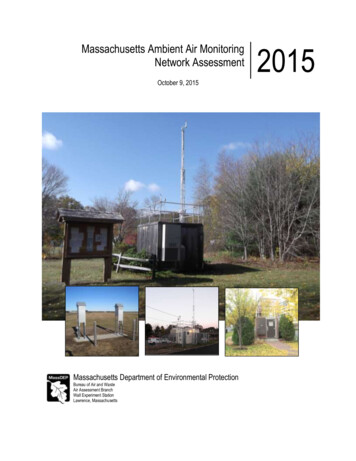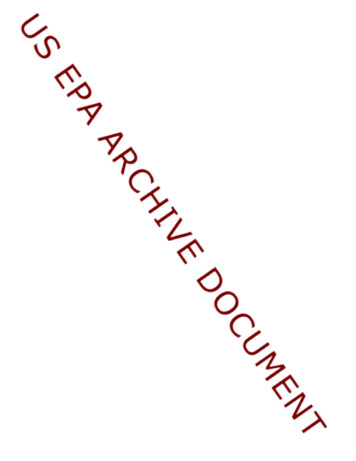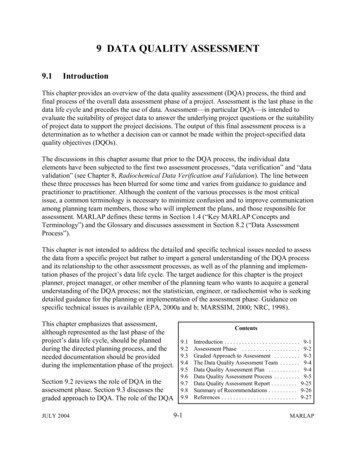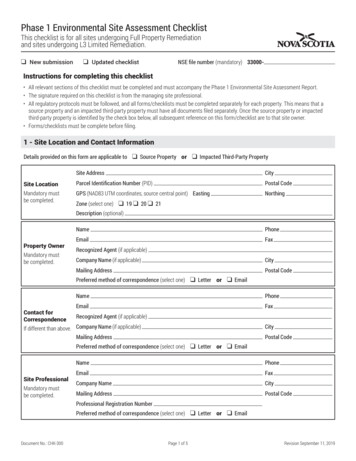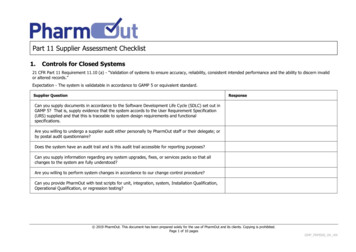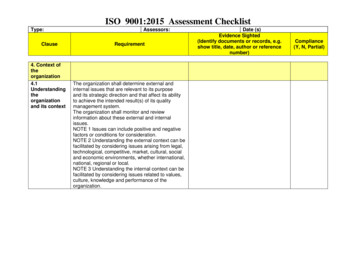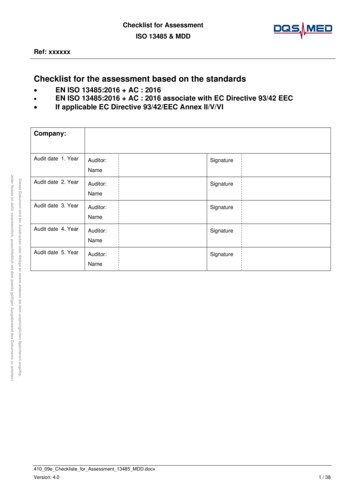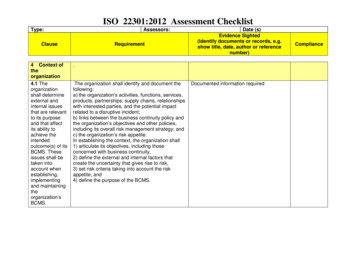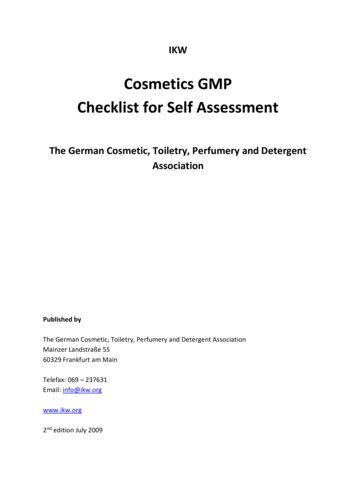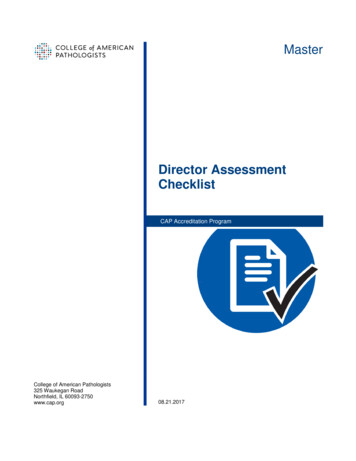
Transcription
Designing a Network Assessment for an Ambient Air Monitoring ProgramAgency Name Date PreparedByThis document is intended to help facilitate compiling an assessment of an agency’s air quality surveillance system by State and wheredelegated, local air monitoring programs. The requirement to submit an assessment of the air quality surveillance system is provided forin §58.10, (d) which states:“The State, or where applicable local, agency shall perform and submit to the EPA Regional Administrator an assessment of theair quality surveillance system every 5 years to determine, at a minimum, if the network meets the monitoring objectives defined inappendix D to this part, whether new sites are needed, whether existing sites are no longer needed and can be terminated, andwhere new technologies are appropriate for incorporation in the ambient air monitoring network. The network assessment mustconsider the ability of existing and proposed sites to support air quality characterization for areas with relatively highpopulations of susceptible individuals (e.g., children with asthma), and, for any sites that are being proposed for discontinuance,the effect on data users other than the agency itself, such as nearby States and Tribes or health effects studies. For PM2.5, theassessment also must identify needed changes to population-oriented sites. The State, or where applicable local, agency mustsubmit a copy of this 5-year assessment, along with a revised annual network plan to the Regional Administrator. The firstassessment is due July 1, 2010.”Use of this document is not required, but should be of benefit to agencies and readers of the assessments so that there is a level ofconsistency in how assessments are prepared. Monitoring agencies that have already started developing their network assessment thatmay include other important analysis and/or questions not provided for in this document or the tools EPA-OAQPS have developed areencouraged to include that information so it can be shared with EPA and other readers of the network assessment. Monitoring agenciesarea also encouraged to work with their EPA Regional Offices on coordinating information from other monitoring programs within theirRegion as well as monitoring programs in other EPA Regions.The assessment should provide a description of the networks and the relative value of each monitor and station with consideration of thedata users. Annual monitoring network plans are to provide for actual proposed changes to the networks that are consistent with thefindings of the five year assessment.Version 1.0 – 2010 Assessment-1-
Designing a Network Assessment for an Ambient Air Monitoring ProgramAgency Name Date PreparedByThis document is organized into several sections as described below:A.B.C.D.E.F.G.H.I.J.K.L.M.N.O.GENERAL Q/A’s ON THIS NETWORK ASSESSMENTSUMMARY OF STEPS TO PRODUCE A NETWORK ASSESSMENTINFORMATION TO GATHERAIR QUALITY SUMMARYPOPULATION SUMMARYMETEORLOGICAL SUMMARYEMISSIONS INVENTORY SUMMARYMONITORING NETWORK/DATA GENERAL QUESTIONSPOLLUTANT SUMMARY – All PollutantsPOLLUTANT SUMMARY – PMa. PM2.5b. Chemical Speciation Networkc. PM10POLLUTANT SPECIFIC SUMMARY – Ozone and precursorsa. Ozoneb. PAMSPOLLUTANT SPECIFIC SUMMARY – Additional NAAQS Gasesa. COb. SO2c. NO2POLLUTANT SPECIFIC SUMMARY – Lead (Pb)TECHNOLOGYCROSS-CUTTING NETWORK CONSIDERATIONSATTACHMENT A - NAAQS SUMMARYATTACHMENT B - MONITORING STRATEGIES FOR EXISTING AND POSSIBLY REVISED NAAQS MONITORINGNETWORKSATTACHMENT C – MONITOR AND STATION NETWORK SUMMARYVersion 1.0 – 2010 Assessment-2-
Designing a Network Assessment for an Ambient Air Monitoring ProgramAgency Name Date PreparedByATTACHMENT D – INDEX OF HEALTH STUDIES AND ASSOCIATED AMBIENT AIR MONITORING DATA (Will beprovided separately)Version 1.0 – 2010 Assessment-3-
Designing a Network Assessment for an Ambient Air Monitoring ProgramAgency Name Date PreparedByA. GENERAL Q/A’s ON THIS NEWORK ASSESSMENT1. How comprehensive does our Network Assessment need to be?Each network assessment should cover the NAAQS, Air Toxics and meteorological monitoring networks and associated technology for whichthe monitoring agency has responsibility. However, emphasis in the assessment should be placed on those NAAQS’ and HAP’s which havethe highest risk issues in the network of concern. In most cases this will focus on PM (both PM2.5 and for some areas PM10) as well as ozone.2. How long does my Network Assessment have to be?There is no specific length which is required or advised. However, we do recommend following a style where information is conciselypresented so that readers can quickly find and review recommendations. For detailed tables and maps that present the same information acrossmany stations or metropolitan areas, we recommend writing the network wide information in the assessment with detailed information by siteor metro area in an appendix. We do advise use of an “Executive Summary” where your agency can quickly summarize the priorities of yournetwork and how this assessment has informed that process.3. Does the five-year Network Assessment have to be posted for public comment?There is not a requirement to solicit public comment on a Network Assessment; however, monitoring agencies are encouraged to reach out todata users as well as post their network assessment on their web site.4. With so many NAAQS pollutants in various stages of review, how should we handle value judgments on pollutant networks when theNAAQS may change?Since each of the NAAQS is planned to stay on a five year review cycle where pollutants are in various stages of review, there will likelynever be an optimal time to do an assessment. However, assessments need to be performed even while the NAAQS are changing. Forpurposes of this assessment we recommend monitoring agencies consider both final and proposed NAAQS changes when reviewing yournetworks. However, agencies should not propose any shifts in monitoring resources where a final decision on the NAAQS and associatedmonitoring has not taken place. Where NAAQS’ are finalized, agencies can and should identify potential network changes in the AnnualMonitoring Network Plan. Attachment A presents the most recently available timeline for each NAAQS review cycle. Given the timelinepresented, we recommend both NO2 and SO2 be incorporated in the assessment according to the revised and proposed NAAQS’ respectively.5. Does our assessment need to specifically identify which stations are candidates for removal and addition?Version 1.0 – 2010 Assessment-4-
Designing a Network Assessment for an Ambient Air Monitoring ProgramAgency Name Date PreparedByWhile not specified by regulation, we highly recommend your agency prioritize the monitoring stations and pollutants in your network,including estimating start-up and end dates, where applicable, for stations and monitors. Attachment C provides a template in the form of atable for qualitatively addressing this question. The table allows inclusion of important information such as monitor objective andrecommendations by monitor to inform network planning and data users6. Can our agency work with other monitoring agencies or a multi-state organization to produce a network assessment that is multiAgency or multi-State in nature?Yes, agencies may work collaboratively with other agencies, through multi-state organizations, or through contractors to meet therequirements of the planned five-year assessments. Where applicable, monitoring agencies will have to work with neighboring States tohandle transport areas and CBSA’s that cross State lines,7. How does the five-year Network Assessment relate to the Annual Monitoring Network Plan?The network assessment is intended to provide a comprehensive review of your agency’s monitoring network as described earlier. The annualmonitoring network plan is intended to be the yearly update of the planned changes to your network in consideration of the latest assessmentyour agency has performed. For example, the five year assessment might provide a recommendation that PM10 stations are of relatively lowervalue in your agencies network, while the annual monitoring network plan would recommend which stations are to be shut down in whichyear.8. Can the Network Assessment be in the same document as the Annual Monitoring Network Plan or do they need to be separatedocuments?Yes, these documents can be combined into one document so long as all the requirements of both documents are met. This document wouldbe subject to the public comment period.9. What should we do if we identify new monitoring needs such as previously unmonitored areas that might have high local exposures,but are unsure if we will ever have the resources to support new activities?We highly recommend that the Network Assessments take an approach of valuing the relative priority of new measurements and stationswithout immediately factoring in how the agency is going to secure the resources to implement new monitoring. For example, if there areinadequacies in the network, they should be identified and discussed (e.g., more PM2.5 instruments are needed but can not be funded, profilersare needed to develop a more thorough understanding of boundary layer conditions and funding sources are being investigated). We are notVersion 1.0 – 2010 Assessment-5-
Designing a Network Assessment for an Ambient Air Monitoring ProgramAgency Name Date PreparedBysaying you should say you need a new site in every jurisdiction not previously monitored; however, if there are locations in your network thatmay lead to a change in where the design value location of a pollutant is measured they should be identified. Choices for how to informexploring these locations further does not immediately mean a new SLAMS has to be set up. Options might include setting up a specialpurpose monitor, a mobile monitor, or local scale modeling. Agencies are encouraged to work with their Regional Offices on prioritizing newmonitoring needs relative to existing monitoring. When prioritizing monitoring needs, agencies should be prepared to also identify lowervalue monitoring that may have served its purpose and be discontinued so that equipment and staff time can be applied to new monitoringneeds as applicable.10. Can our agency explore costs in detail to inform how the assessment might affect our resource needs?Yes, while the network assessment is primarily about looking ahead and optimizing monitoring networks and equipment to meet the mostimportant data uses, agencies should also be thinking about how changing network priorities will affect resource needs. Agencies are notrequired to explain or share costs in the assessment; however, for some agencies it may be helpful to provide information to inform readers,including interested third party data users and EPA on the impacts of continuing to support, add new, or discontinue monitoring.Version 1.0 – 2010 Assessment-6-
Designing a Network Assessment for an Ambient Air Monitoring ProgramAgency Name Date PreparedByB. SUMMARY OF STEPS TO PRODUCE A NETWORK ASSESSMENTThe following steps summarize the recommended activities to assemble and produce your agency’s network assessment. The execution ofactivities may be run in parallel or differently than presented here; however, all of these steps should be accounted for to successfully produce anetwork assessment.1. Identify internal team and leader who will produce the network assessment. An internal assessment team should have strong writingand technical skills in air quality characterization necessary to assemble a network assessment.a. We recommend the team include, at a minimum, contacts from within the monitoring program, air quality forecasting, assessmentand/or SIP development, and outreach or communications. Since each air quality management program is organized differentlyand many organizations have staff who wear multiple hats, the actual members will likely vary significantly from one assessmentteam to another; however, the skills and responsibilities should be similar.b. We highly recommend that the team have a leader who is ultimately responsible for producing the assessment on a timeline necessary to meet the July 1, 2010 requirement for submission to each applicable EPA Regional Office.c. Have an internal kick-off meeting to go over the goals of the assessment, how the work is to be done, and if your agency has anyadditional tasks or questions that are to be addressed in the assessment.2. Gather network, air quality, emissions, population, and other appropriate information for use in the network assessment. Thisshould include use of the tools EPA has made available and other information available for assembling the network assessment. A list ofthese tools and where to find information is available in section C of this document. We recommend organizing this information in both:a. Hard copy such as in binders and/orb. Electronically on a shared drive within your organization or similar so that all team members have access.3. Address questions on the measurements and use of data identified in this document. By answering the questions presented later inthis document you should be in good shape to begin assembling your assessment4. Seek input from internal and external data users. We recommend you:a. Identify a list of internal and external data users who utilize your data.b. Summarize a list of questions on their use of data and preferences for stationsc. Carry out and document interviews.5. Draft Outline of Network Assessment. We recommend you:a. Prioritize the pollutants of concern for your networkb. Set up an outline to support the pollutants of concern and supporting monitoringVersion 1.0 – 2010 Assessment-7-
Designing a Network Assessment for an Ambient Air Moni
network assessment. 1. Identify internal team and leader who will produce the network assessment. An internal assessment team should have strong writing and technical skills in air quality characterization necessary to assemble a network assessment. a. We recommend the team include, at a minimum, contacts from within the monitoring program, air quality forecasting, assessment
